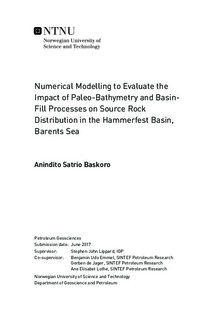Numerical Modelling to Evaluate the Impact of Paleo-Bathymetry and Basin-Fill Processes on Source Rock Distribution in the Hammerfest Basin, Barents Sea
Master thesis
Permanent lenke
http://hdl.handle.net/11250/2453261Utgivelsesdato
2017Metadata
Vis full innførselSamlinger
Sammendrag
In basin and petroleum system modelling, the paleo-bathymetry and distribution of organic matter within the source rock are important properties yet they are uncertain and are often be considered as constant or homogeneous. In this study, high resolution 3D models are produced with their heterogeneities of paleo-bathymetries, basin-fill processes and source rock distributions, employing numerical modelling for the three most important source rock intervals; the Early-Mid Triassic, the Late Jurassic, and the Early Cretaceous, in the Hammerfest Basin. More importantly, the study attempts to further analyse the factors controlling the source rock distribution by linking the paleo-bathymetry and basin-fill processes. The models are validated by sand fraction (SF), total organic carbon (TOC) and hydrogen index (HI) data. The three source rock intervals show distribution models with diverse values for each parameter. The paleo-water depths vary from 2200 m to 50 m, while the sedimentation rates are between 1 and 48 cm/ka with siliciclastic dominated deposition, and thus reflect different basin-fill processes and tectonic development through time. As a result, the source rocks are composed by various organic matter source types, from marine organic matter to terrigenous and residual organic matter. The source rocks have a range of quantity (TOC from 0.1 to 14 wt%) and quality (HI from 24 to 344 mgHC/gTOC) with poor to very good source rock potential. In general, the Late Jurassic Interval is the best source rock in the study area with good to very good source rock potential. The main reason identified is very high primary productivity with favourable basin-fill process and depositional environment for source bed deposition. With these selected examples, it is demonstrated how the paleo-bathymetry and basin-fill processes control the distribution of the source rock properties. To summarize, the interaction between paleo-bathymetry and basin-fill processes affects the distribution of the source rock especially in terms of organic matter quantity and their dispersal as well as preservation condition.
